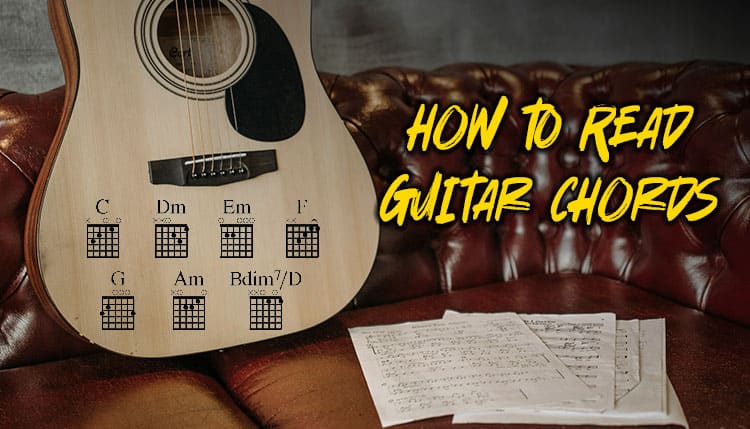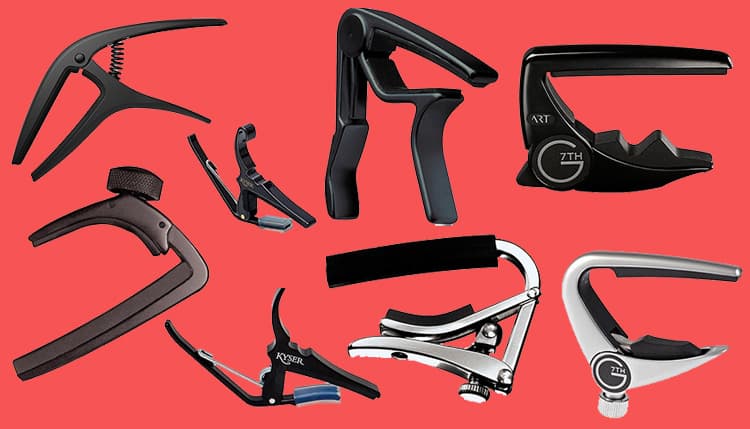Ever picked up a guitar, strummed a chord, and wondered why it sounded more like a car crash than music? You’re not alone!
In fact, a staggering 90% of new guitarists don’t know how to read guitar chords. But don’t fret (pun intended)! I’m here to guide you through the magical world of guitar chords.
By the end of this article, you’ll be decoding those mysterious diagrams like a pro. Let’s dive in and get those fingers moving!
Understanding Guitar Chord Diagrams
Hey there, budding rockstar! If you’re picking up the guitar, cracking the code of chord diagrams is your first backstage pass.
Think of these as your map to finger placement on that six-string wonder, showing exactly where your fingers need to dance around.
Explanation of Vertical Lines (Strings) and Horizontal Lines (Frets)
Alright, so imagine you’re peeking down at your guitar. Those vertical lines in the diagram? Yep, they’re the strings themselves. From left to right:
- You’ve got the chunky low E string on the far left.
- On the far right? The high E string, the skinny one.
Then you’ve got horizontal lines—these are the frets. The top line is the nut (fancy name for the spot your strings rest at the guitar’s head). Beneath it, you’ll see the first fret, second fret, and so on, like stairs you’d climb with your fingers.
How to Interpret Dots and Numbers on the Diagram
Now, let’s talk dots and digits. Dots say, “Hey, put your finger here!” on a particular fret and string. Those numbers? They’re your finger IDs.
| Finger | Number |
|---|---|
| Index | 1 |
| Middle | 2 |
| Ring | 3 |
| Pinky | 4 |
| Thumb | T |
Understanding Open Strings and Muted Strings
Here’s the deal with open strings: When you see a circle above the nut in the diagram, just let that string sing without pressing any fret.
But if you spy an ‘X’? Keep that string quiet—don’t play it, or maybe even lightly touch it to mute it.
| Symbol | Meaning |
|---|---|
| O | Open string |
| X | Muted string |
Common Symbols Used in Chord Diagrams (e.g., ‘X’ for Muted Strings, ‘O’ for Open Strings)
So let’s wrap it up with a cheat sheet:
- Dots: These are where your fingers say hello to the frets.
- Numbers inside dots: Assign each finger its mission.
- O: Let that string sing open.
- X: Shhh, don’t strum this one.
Nailing these symbols will have you playing chords like a pro in no time!
Getting a Grip on Finger Placement
Learning to read guitar chords is like finding a hidden treasure map for budding guitarists. Nail down finger placement, and you’re on your way to sounding like a rockstar.
Let’s chat about how you can easily match those squiggly chord diagrams to your guitar, dodging some of the potholes along the way.
Making Sense of Guitar Diagrams
Think of guitar chord diagrams as those flat-pack furniture instructions, but way less frustrating (we promise!).
Each vertical line mirrors a string on your guitar, and the horizontal ones are the frets—easy peasy.
- The vertical string lines from left to right are: E (the big one), A, D, G, B, and e (the tinny one).
- Horizontal lines: top’s the nut (like zero fret), below that, you’re looking at frets 1, 2, 3, and so on.
Line those babies up with your guitar, and you’ll nail the finger placement like a pro.
Fingering Tricks to Strum By
The secret to crystal-clear sounds and fingers that don’t cry: perfect placement.
- Stay close to the fret with your fingers, ’cause who wants to work harder than they have to? It’s all about getting that rich sound without the extra effort.
- Keep things chill with a relaxed hand. A comfy hand equals smooth changes from one chord to the next.
- Use your fingertips like they’re weapons of mass destruction—precision tools to press strings, without touching neighbors, because buzz kills the vibe.
Getting the Numbers Game
Each chord diagram comes with a secret code—a number code. Here’s the 411:
| Finger | Number |
|---|---|
| Index Finger | 1 |
| Middle Finger | 2 |
| Ring Finger | 3 |
| Pinky Finger | 4 |
| Thumb | T |
Master this intel to get your fingers marching to the right spots.
Pitfalls to Dodge in Fingerland
Some rookie errors can trip you up, so let’s cut ’em down to size:
- Skipping the Finger Codes: Stick to the numbers—wrong fingers equal more struggles and roadblocks on your path.
- The Heavy-Handed Approach: Strike a balance—too much might cramp your style, too little could mess up your melody with that dreaded buzzing.
- Ignoring Hand Angles: Keep thumbs thumb-y and at the guitar’s back, while your wrist moves with the groove for stress-free jamming.
Stick to these nuggets of wisdom, and before you know it, you’ll be decoding chord diagrams and rockin’ out like it’s second nature.
How to Read Guitar Chords for Beginners
Getting the hang of guitar chords is like unlocking a treasure chest of musical fun. Let’s make it simple and exciting for all you aspiring guitar heroes.
Open Chords vs. Barre Chords
Open chords are the friendly chords you meet first. They’re simple because you play with some strings wide open—fingers chilling without any frets. These chords sound rich and warm, making them a favorite for newbies.
Barre chords are a bit of a workout for your fingers. You press down a whole bunch of strings with one finger across a fret. Once you get the hang of these, they’re like secret keys to playing the same shape anywhere on the neck. Talk about a game-changer!
| Type of Chord | Complexity | Examples |
|---|---|---|
| Open Chords | Easy | C major, G major |
| Barre Chords | Intermediate | F major, B minor |
Major and Minor Chords: What’s the Difference?
Major chords are the sunshine of the chord world, spreading happy vibes. They’re made up of three notes: the root note, a major third, and a perfect fifth.
Minor chords are for those times when you need a little bit of soul and emotion. They share two notes with majors but swap the major third for a minor third to create that melancholic essence.
| Chord Type | Mood | Examples |
|---|---|---|
| Major | Cheerful | C major, G major |
| Minor | Melancholic | A minor, E minor |
Power Chords: The Backbone of Rock Music
Power chords pack a punch and are the backbone of rock and punk. Keep it simple with just two or three notes: the root and the fifth. Sometimes you throw in the octave for some extra kick. They’re quick and easy to shift around, making them essential for any rocker.
| Chord Type | Complexity | Examples |
|---|---|---|
| Power Chords | Easy | G5, A5 |
7th Chords: Adding Flavor to Your Playing
7th chords are like adding a secret spice to your music. They stretch beyond the trio of root, third, and fifth by adding a fourth note, making your sound richer and more colorful. Dive into major 7ths, minor 7ths, and dominant 7ths to explore genres like jazz, blues, and funk.
| Chord Type | Complexity | Examples |
|---|---|---|
| Major 7th | Intermediate | Cmaj7, Gmaj7 |
| Minor 7th | Intermediate | Am7, Em7 |
| Dominant 7th | Intermediate | G7, D7 |
With these chords at your fingertips, let’s create some tunes that feel right to the soul. Glide through these chord types, practice those transitions, and soon enough, you’ll be crafting music magic with your guitar.
Step-by-Step Guide to Reading Your First Guitar Chords
Learning to read guitar chords is like opening a treasure chest of musical wonders. With just a few fundamental chords, we’ve got ourselves a solid start that’ll make playing tunes more fun and less scary.
Starting with the A, D, and E Chords
Let’s kick things off with the chords A, D, and E. These guys are like the holy trinity of guitar music. Seriously, they’re everywhere!
A Major Chord:
- Put your index finger on the 2nd fret of the D string.
- Middle finger goes on the 2nd fret of the G string.
- Ring finger chills on the 2nd fret of the B string.
- Now, strum your way down from the 5th string.
D Major Chord:
- Plop your index finger on the 2nd fret of the G string.
- Middle finger hits the 2nd fret of the high E string.
- Ring finger lands on the 3rd fret of the B string.
- Strum starting from the 4th string.
E Major Chord:
- Index finger takes the 1st fret of the G string.
- Middle finger parks on the 2nd fret of the A string.
- Ring finger sets its sights on the 2nd fret of the D string.
- Strum with gusto, all six strings.
Progressing to G, C, and F Chords
Once those first chords feel comfy, let’s move on to the G, C, and F chords. These are just as common and crucial for belting out more songs.
G Major Chord:
- Index finger: 2nd fret on the A string.
- Middle finger: 3rd fret on the low E string.
- Ring finger: 3rd fret on the B string.
- Pinky: 3rd fret on the high E string.
- Go ahead, strum all six strings.
C Major Chord:
- Index finger: 1st fret of the B string.
- Middle finger: 2nd fret of the D string.
- Ring finger: 3rd fret of the A string.
- Strum starting from the 5th string.
F Major Chord:
- Lay your index finger across all strings on the 1st fret.
- Middle finger: 2nd fret of the G string.
- Ring finger: 3rd fret of the A string.
- Pinky: 3rd fret of the D string.
- And strum away on all six strings.
Tips for Smooth Transitions Between Chords
Switching chords can be a bit of a hassle at first. Here’s how we can make it easier:
- Practice your moves slowly before speeding up the jam session.
- Keep those fingers super close to the strings to cut down on unnecessary movements.
- Work on changing chords without strumming first. Nail the finger placements.
- A metronome can turn you into a rhythm master.
Practice Exercises for Beginners
Remember, practice is our best buddy for nailing chord changes. Here’s how we can kickstart our practice:
Exercise 1: Basic Chord Jam
- Strum that A major chord four times.
- Slide to a D major chord and strum four times.
- Shift to an E major chord, strumming four times.
- Loop this cycle for several minutes.
Exercise 2: The G-C-D Shakedown
- Hit the G major chord, strumming four times.
- Shift to C major and strum four times.
- Slip to D major and strum four times.
- Keep repeating, speed it up if you’re feeling it!
Exercise 3: Toggle Time with E and F Chords
- Strum E major four times.
- Move to F major and strum away four times.
- Alternate between E and F, strumming each four times.
| Exercise | Chords in Play | Strums per Chord |
|---|---|---|
| Basic Chord Jam | A, D, E | 4 each |
| G-C-D Shakedown | G, C, D | 4 each |
| Toggle Time | E, F | 4 each |
By sticking with these chords and practices, we’re not just making noise; we’re setting ourselves up for a guitar journey that’s all thrill and no chill!
Common Challenges and How to Overcome Them
Figuring out guitar chords is no walk in the park, but we’ve got your back. Let’s tackle some typical hurdles and break them down. We promise, after a bit of practice, you’ll be strumming along like a pro.
Dealing with Finger Pain and Building Calluses
Pain in your fingers is a normal struggle for rookies. Those fingertips aren’t used to wrestling with guitar strings just yet.
- Building Calluses: Like superheroes, your fingers get tougher with practice. Those hard little patches will save you! Shoot for daily practice, even if it’s only 15-20 minutes. Bit by bit, you’ll toughen up.
- Proper Finger Pressure: Only press hard enough to get a good sound. Pushing too hard just ups the pain factor without any real benefit.
Tricks for Stretching Your Fingers Effectively
Getting your fingers to dance around those strings might feel like trying to catch slippery eels at first. But guess what? Stretching exercises are the secret sauce.
- Finger Stretching Exercise:
- Hold up your hand and spread those fingers as wide as possible.
- Hold for a few seconds, then chill. Do this 5-10 times.
- Practice placing your fingers on different frets to gain reach.
- Spider Exercise: Try placing your fingers one by one – index on the 1st fret of the low E string, second finger on the 2nd fret of the A string, third on the 3rd fret of the D string, and pinky on the 4th fret of the G string. Play each note in order, shimmy up a fret, and do it again.
Handling Difficult Chord Shapes
Barre chords and other finger-mashing shapes can feel like trying to do yoga in a phone booth.
- Breaking Down the Chord: Don’t tackle the whole beast—start with just part of it. Tackle the barre first (pressing down all strings with a single finger), then bring in the cavalry (other fingers).
- Finger Placement Tips:
- Keep your thumb anchored behind the neck and your fingers nice and curved.
- Make sure each fingertip is smack dab on the string.
Using a Capo to Make Chords Easier
Ah, the capo. This little gadget is a lifesaver for beginners. It acts like a bridge on the fretboard, shortening string length so frets are closer together.
- Simplified Chords: A capo place up on that neck and boom—easier chords with less finger gymnastics.
| Capo Position | Key Change Example |
|---|---|
| No Capo | G |
| 1st Fret | G# / Ab |
| 2nd Fret | A |
| 3rd Fret | A# / Bb |
| 4th Fret | B |
- Transposing: Say your song is packed with tough chords. Plop the capo higher, and you can use simpler shapes. Like, if a tune’s in B, pop a capo on the 2nd fret so you can play it using A chord forms.
Follow these tips and watch those guitar chord blues melt away. Expect some bumps along the way, but stick with it—your progress might creep, but it’ll definitely grow with steady effort.
Leveraging Technology to Better Read Guitar Chords
Let’s be real, technology’s pretty much the best sidekick when it comes to figuring out how to read guitar chords. From apps on our phones to stuff online, there’s a whole bunch of goodies out there to help us jam easier and with a little more fun.
Awesome Apps for Jamming and Chord Practice
We’ve lined up some killer apps to help get those guitar chords under our fingers. Check out these crowd favorites:
| App Name | What It Offers | Where to Find It | Cost |
|---|---|---|---|
| Yousician | Fun lessons, feedback on the spot, multiple practice modes | iOS, Android | Free with optional purchases |
| Guitar Tricks | Tons of lessons, step-by-step guides, chord locator | iOS, Android | Subscription needed |
| Fender Play | Lessons through video, guided learning paths, hefty song list | iOS, Android | Subscription required |
Yousician’s all about giving live feedback, a hit for beginners wanting instant tips. Guitar Tricks has more lessons than you can shake a stick at and a nifty chord finder. Fender Play is stacked with video guides and paths that keep you on track.
Web Resources and YouTube Channels for the Eyes and Ears
For those of us who learn best by watching, the internet is a goldmine. Here’s some of the coolest places to check out:
- Ultimate Guitar: Your go-to for a massive collection of chords, guitar tabs, and song lyrics. Perfect if you’re itching to play songs everyone loves.
- Justin Guitar: Offers video lessons that walk you through from basic strumming to some pretty slick moves.
- Marty Music: Has lessons that are stupid simple to follow, with a focus on different genres and playing vibes.
These sites let us see and hear how to play chords, so we can easily copy them on our guitars.
Digital Tuners: Your Best Friend in Keeping the Tune
We all know that knowing how to tune a guitar is a must. These digital tuners are just what we need:
| Tuner | What’s Cool About It | Places to Find It | Pricing |
|---|---|---|---|
| GuitarTuna | Super accurate, offers various tuning modes | iOS, Android | Free with optional buys |
| Fender Tune | Auto/manual tuning, super easy to use | iOS, Android | No charge |
| Polytune | Tunes all strings together, cuts down time | iOS, Android | Freebie |
GuitarTuna’s famous for being spot-on with its tuning and has loads of modes. Fender Tune is perfect for newbies with its simple auto/manual modes. Polytune lets you tune all strings in one go, quick and easy.
By grabbing these tech tools, we’re not just learning theory; we’re making guitar playing something we actually understand and enjoy. So grab your guitar, fire up an app, and let’s strum our way to bliss.
Progressing Beyond Basic Chords
Introduction to Chord Progressions
Alright, since we’ve nailed some basic chords, let’s jazz things up with chord progressions. These are like the secret sauce that makes a song, well, a song. Chord progressions show you how chords hang out together harmonically and give life to tunes. Getting comfy with guitar playing means dabbling with different progressions and regularly noodling around to get those slick transitions and groovy rhythms down.
| Common Chord Progressions | Example Chords Used |
|---|---|
| I-IV-V | C – F – G |
| ii-V-I | Dm – G – C |
| I-vi-IV-V | C – Am – F – G |
Understanding Chord Families and Keys
Chord families are groups that vibe well together, kicking it in their unique key. Think of each key as a musical family reunion, where each chord plays a part. Getting these families under your fingers opens up wild possibilities for playing and jamming. You’ll see Roman numerals (like I or ii) repping their spots on the music scale.
| Key | I | ii | iii | IV | V | vi | vii° |
|---|---|---|---|---|---|---|---|
| C Major | C | Dm | Em | F | G | Am | Bdim |
| G Major | G | Am | Bm | C | D | Em | F#dim |
Exploring Alternate Voicings for Common Chords
Alternate voicings are like those fancy tops you have for special occasions—they’re different ways to style a chord, bringing in fresh vibes and emotions. They can change the whole feel of your jam. Why stick to plain vanilla E major when you could sprinkle a bit of E major 7th or E sus4 for a richer flavor?
| Chord | Standard Voicing | Alternate Voicing |
|---|---|---|
| C Major | x32010 | x35553 |
| G Major | 320003 | 355433 |
| A Minor | x02210 | 577555 |
Tips for Reading Chord Charts in Real-Time
Being able to read chord charts on the fly is a must-have skill for rocking out with the band or bossing it on stage. Here’s how you can get the hang of it:
- Know Your Chord Symbols: Get cozy with the shorthand used in charts so they don’t throw you off.
- Smooth Transitions Are Key: Glide between chords to stay in tune with the beat, like a dance partner.
- Metronome Time: This helpful tick-tock buddy keeps your timing tight.
- Feel the Rhythm: Pay attention to the vibes and strumming cues in the chart.
- Peek Ahead: Sneak a look at upcoming chords so you’re not caught off guard.
Master these tips and you’ll be cruising through chord charts, making your guitar playtime far more enjoyable and way more fun!
You Now Know How to Read Guitar Chords
Congratulations! You’ve just taken your first steps into the wonderful world of guitar chords.
Remember, learning how to read guitar chords is a journey, not a destination. It might feel challenging at first, but with consistent practice, you’ll be strumming your favorite songs in no time.
Don’t get discouraged if your fingers feel clumsy – even Jimi Hendrix started somewhere! Keep at it, celebrate small victories, and most importantly, have fun!
Why not challenge yourself to learn one new chord every day for the next week? Your future rockstar self will thank you.
Now, pick up that guitar and start making some noise – I mean, music!







